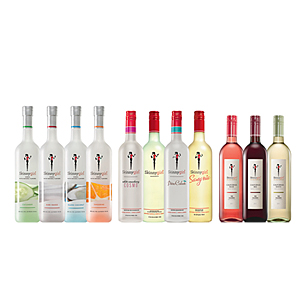2012 State of the Industry: Wine and Spirits
Innovative flavors and sweet wine varietals help to continue the growth of wine and spirits. Flavored vodkas, whiskeys and bourbons suit consumers who are looking for variety and value, said Danny Brager, vice president, group client director and head of the beverage alcohol team at Nielsen, New York City, in Beverage Industry’s April issue.
looking for variety and value, said Danny Brager, vice president, group client director and head of the beverage alcohol team at Nielsen, New York City, in Beverage Industry’s April issue.
In the last year, the industry has seen such introductions as Van Gogh Vodka’s Peanut Butter and Jelly-flavored vodka, Gummy- and Cookie Dough-flavored vodkas from White Rock Distilleries, and Big Dill pickle-flavored vodka under Sazerac Co.’s Naked Jay brand name. Outside of the vodka category, products such as Brown-Forman Corp.’s Southern Comfort Fiery Pepper and its Jack Daniel’s Tennessee Honey also have sparked flavor innovation.
An improved economy has led to a return to premiumization, according to the Distilled Spirits Council of the United States’ (DISCUS) 2011 industry review. Spirits suppliers saw year-to-year volume growth of 2.7 percent resulting in nearly 196 million 9-liter cases, and sales growth of approximately 4 percent to just shy of $20 billion, said Peter Cressy, president and chief executive officer of DISCUS, in a statement. This resulted in another three-tenths of a point in market share gains against beer, reaching 33.6 percent of the total beverage alcohol market. This represents approximately five points of market share since 2000, worth approximately $2.9 billion annually, the council reported. Likewise, revenue market share for wine increased 1.4 percent, stealing some share from beer.
Volume for premium vodkas rose 11 percent last year and super-premium vodkas were up nearly 13 percent, DISCUS data showed. Growth in the rum category was driven by high-end and super-premium offerings, which were up nearly 15 percent, it added. In the bourbon and Tennessee whiskey category, volume for premium, high-end and super-premium offerings increased 2.4 percent, 5.6 percent and 15.4 percent, respectively, according to DISCUS data. Volume for value tequilas was up 7 percent, while high-end and super-premium volume in the tequila segment rose 9 percent and around 11 percent, respectively. Scotch and Irish whiskey remained concentrated in high-end and super-premium offerings, DISCUS noted.
Economic recovery also might place premium-priced ready-to-drink and ready-to-pour cocktails in a position of growth as consumers choose convenience instead of price, the report said. In fact, DISCUS’ report showed that the pre-mixed cocktails segment experienced 20 percent of its growth in premium offerings. Within the segment, low-calorie options are appealing to consumers. Beam Inc.’s Skinnygirl brand, which it acquired in 2011, offers low-calorie cocktails including the original Margarita as well as a new Piña Colada variety, naturally flavored vodkas and a wine collection.
Alternative flavors and innovative packaging formats, such as cans, boxed drinks and pouches, also have caught consumers’ attention, such as Constellation Brands’ Arbor Mist Frozen Wine Cocktails in single-serve pouches.
In the wine category, sweet offerings and red blends are the biggest trends, Nielsen’s Brager told Beverage Industry in April. The sweet trend started with Moscato and has moved into sweet red blends, he explained. According to a study by London-based Wine Intelligence Ltd., U.S. consumers will drink more sparkling wines this year than ever before. BI
Looking for a reprint of this article?
From high-res PDFs to custom plaques, order your copy today!





